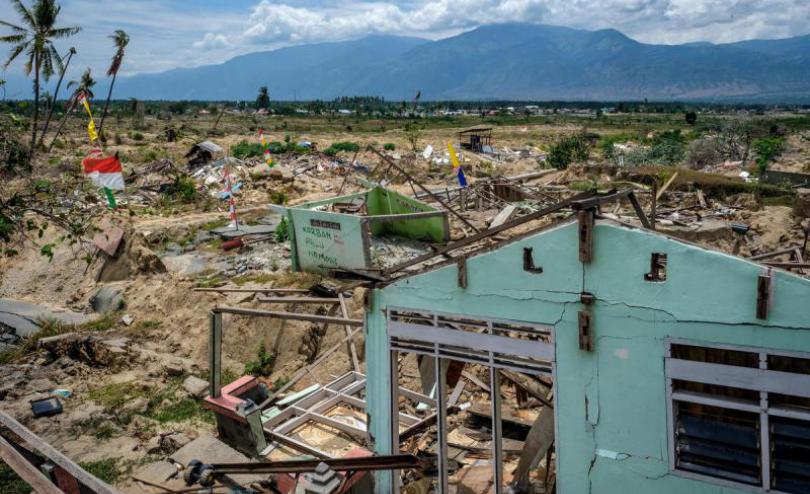At least 6,000 children still in temporary shelters, six months on from Sulawesi disaster

Thousands of children are still in need of permanent housing six months on from the devastating earthquake and tsunami which hit Central Sulawesi in Indonesia in September 2018.
An estimated 6,000 children[1] are still living in temporary housing, and their daily lives involve navigating open sewers and mounds of sharp rubble and being exposed to diseases such as diarrhoea and pneumonia. There has already been a major outbreak of Dengue fever in Indonesia.
“While tens of thousands of people have been reached, six months after this disaster we are extremely concerned about the estimated 6,000 children still living in temporary accommodation such as tents, as well as the thousands more that are living in homes that have been damaged. The temporary accommodation is basic – tents or makeshift homes – and often have bare floors, which flood when it rains,” said Tom Howells, Save the Children’s Response Team Leader in Indonesia.
“Indonesia is no stranger to natural disasters, but 2018 was a particularly brutal year with over 2,000 such events[2]. Over 5000 people lost their lives to earthquakes, tsunamis and landslides across Indonesia in 2018, thousands of others were injured, and tens of thousands more displaced. For many children in Indonesia, 2018 was a defining year in their lives.”
Over 4,300 people were killed and over 170,000 people displaced in the disaster in Sulawesi, which was Indonesia’s deadliest in over a decade. The event also badly damaged or destroyed over 40,000 homes, including those which completely disappeared in the rare ‘liquefaction’ phenomena that caused tracts of land to take on the characteristics of liquid[3].
Salsa, 10, has lived in a tent with her parents since the tsunami destroyed her home. The tent has no floor and the door is covered with a blanket, which cannot be securely closed.
“Because of the big wave, the foundation of our house disappeared… I was with my cousin, I was crying, and looking for my mum,” said Salsa
“Often, when we sleep, there are a lot of mice.”
Since the disaster struck, Save the Children in Indonesia (Yayasan Sayangi Tunas Cilik) has been working to ensure children’s immediate needs are met and basic services can operate. To respond to the urgent shelter needs alone the agency has already reached over 100,000 people with shelter kits, hygiene kits, clean water kits and mosquito nets. The agency has also run carpentry training with handymen from three badly affected villages and provided vulnerable families with cash so they can rebuild their own shelters.
“The scale of destruction means that the relief effort is still needed, even for a disaster-prone country such as Indonesia with strong government capacity. Aftershocks are still being felt six months on and we can see on the ground that these events are very distressing and destabilizing for children and adults alike. However, funds are drying up, and we now call on the international community to remember the children of Indonesia and support the response effort to help the remaining families get over the line,” said Howells.
Save the Children’s response in Sulawesi
Save the Children has been working on the ground in the affected communities since this disaster struck. At the outset we focused on reuniting separated children and providing emergency water, shelter and sanitation to desperate families. Over the coming months, we moved to longer-term sustainable solutions, like building learning centres, helping people rebuild their livelihoods and ensuring people, especially children are prepared for ongoing aftershocks and future disasters.
To date we have reached over 140,000 people, including over 70,000 children. We have distributed shelter kits, hygiene kits and water kits to over 25,000 households, making sure children and their families have a roof over their heads and are less vulnerable to diseases caught through dirty water.
We are running over 50 child-friendly spaces, which give children the opportunity to recover, play, and be children again, while their families rebuild their lives and livelihoods. We have reached over 9000 children and adults through psychosocial interventions, helping them to recover from the intense fear and stress that such a terrifying event will cause. And we’ve established 26 temporary learning spaces, where children can access learning opportunities while their classrooms are rebuilt.
Media Contacts for interviews:
- Fajar Sugandi (in Jakarta): Fajar.Sugandhi@savethechildren.org ; Office +62 (21) – 782 4415| Mobile +62 (811) 8819 912
- Daphnee Cook (Roaming): Email d.cook@savethechildren.org.uk ; Whatsapp: +8801701212608
- During out of office hours, please contact media@savethechildren.org.uk, 0044 7831 650409
[1] The Indonesian National Agency for Disaster Management (BNPB) https://bnpb.go.id/pemulihan-bencana-dan-relokasi-pengungsi-sulawesi-tengah
[2] Indonesia's National Disaster Mitigation Agency (BNPB) https://www.abc.net.au/news/2018-12-28/the-five-most-deadly-natural-disasters-in-indonesia-this-year/10668480
[3] Indonesia's National Disaster Mitigation Agency (BNPB) https://bnpb.go.id/uploads/24/whatsapp-image-2019-02-07-at-144002.jpeg




